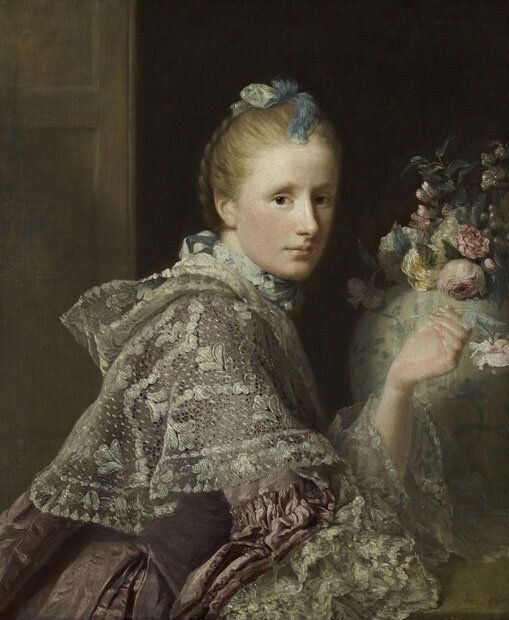One of the most dramatic changes to the Scottish National Portrait Gallery, which recently reopened after an extensive overhaul, is the airy and relit second floor. Artificial lighting, which often distorts oil paintings, has been replaced by an open ceiling which allows natural light in. The tremendous benefits of this illumination can be seen most clearly in an exhibition considering the eighteenth-century Edinburgh milieu that produced some of the greatest thinkers of the modern age. In Citizens of the World: David Hume and Allan Ramsay, we are treated to some of the painter Allan Ramsay's most celebrated works. Throughout the exhibition we can draw connections between the overlapping lives of great enlightened philosophers like Jean-Jacques Rousseau and David Hume.

Ramsay's 1766 portrait of Hume is one of the artist's finest. It has given us an enduring image of Hume: the philosopher is evidently relaxed, and while his gaze suggests a sharp and questioning mind, it is an image of pacific comfort and slightly bloated ease. Contemporaries noted Hume's 'very large and heavy' build, and a face 'by no means an Index of the Ingenuity of his Mind, especially of his delicacy and vivacity'. Hume's direct gaze stands in marked contrast to the diffidence of Ramsay's shrew like portrait of the philosopher Rousseau, clutching at his fur coat and turned away from the viewer. Hume, who had a copy of the portrait, observed Rousseau's 'peevish countenance' was clearly visible.
Ramsay's portraits have a great intensity and he has a remarkable ability not just to convey a likeness in his subjects, but an ability to paint figures that seem to think. His portrait of Hew Dalrymple, was widely celebrated for its realism; the viewer is led to feel they have just stumbled into Dalrymple's study. At his zenith Ramsay can convey an ethereal intimacy and visually lingering style, seen in the painting of his second wife Margaret Lindsay, which highlights an exquisite subtlety of technique.
With Hume, Ramsay's relationship went beyond a mere client patron connection, and the two men regularly corresponded on philosophical matters around beauty and taste. In Ramsay's 1764 pamphlet A Dialogue on Taste, his friend Hume clearly takes the role of Colonel Freeman. Freeman/Hume notes, on the question of improvement, that 'the polite arts, and all the several branches of true learning, have so immediate a connection that they always march together; and it is impossible to find any one of them in a tolerable degree, without finding along with it some portion of each of the rest.'
As the two men spotted, the age was one of intellectual dialogue. Men like James Boswell, who would later define our modern notion of 'biography' in his Life of Johnson shared ideas with Hume (and mistresses in the case of Rousseau); Lord Kames mentored the father of economics, Adam Smith, as well as Boswell. This set made up a group of great thinkers including Alexander Carlyle (called 'Jupiter' because of his classical good looks) and the historian William Robertson. Tellingly, Ramsay was accepted into this group and could engage on an intellectual basis about the theory and science of his craft in a way many artists based in London could not.

The resulting impression, then, is one not simply of social ties, but a tremendous vibrancy of intellectual flowering and cross fertilisation. Not surprisingly Voltaire noted that it was to Scotland that Europe should look to for all ideas of civilisation. Perhaps due to its size, relative to Paris or London, political scientists mixed with economists and botanists in Edinburgh; poets met over drinks with painters and historians. Walter Scott noted another possible explanation:
There is no European nation which, within the course of half a century, or little more, has undergone so complete a change as this kingdom of Scotland...the gradual influx of wealth, and extension of commerce, have since united to render the present people of Scotland a class of beings as different from their grandfathers, as the existing English are from those of Queen Elizabeth's time.
Indeed as Scott hinted, time had in effect telescoped in Scotland during the period; what had taken England centuries was being achieved in decades in Scotland. The resulting explosion in ideas on the fringes of Britain resulted in a widespread obsession with the ideas (and problems) of progress. Thinkers like Adam Smith could literally witness the movement from Highland tribalism to refined civilization in Edinburgh. In the case of the friends Hume and Ramsay, an intense dialogue developed about the nature of the senses and how we, as humans, define what is beautiful and what is not. Such careful observations resulted in ideas of progress and improvement that would influence the ideology, not simply of Victorian Britain, but the modern world as we know it. This exhibition gives us some idea of why Scottish thought in this period has been praised with the 'invention of the modern world' as we know it.
Citizens of the World: David Hume and Allan Ramsay is a free exhibition at the Scottish National Portrait Gallery in Edinburgh. It runs until 31st December 2015.
